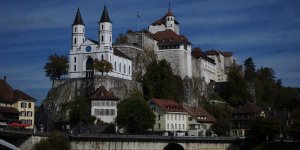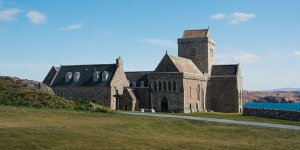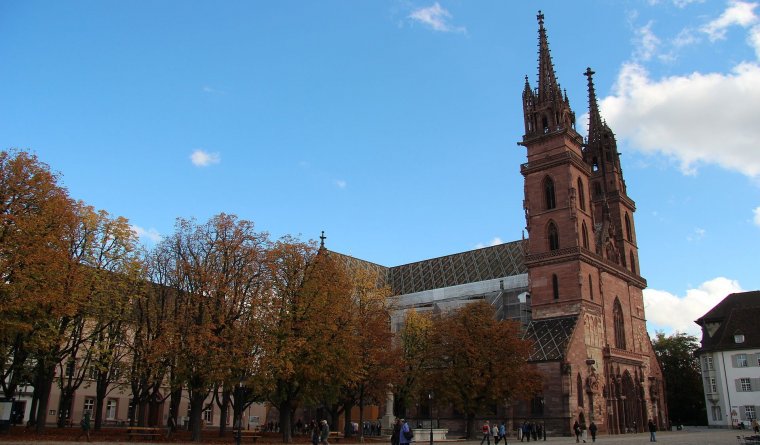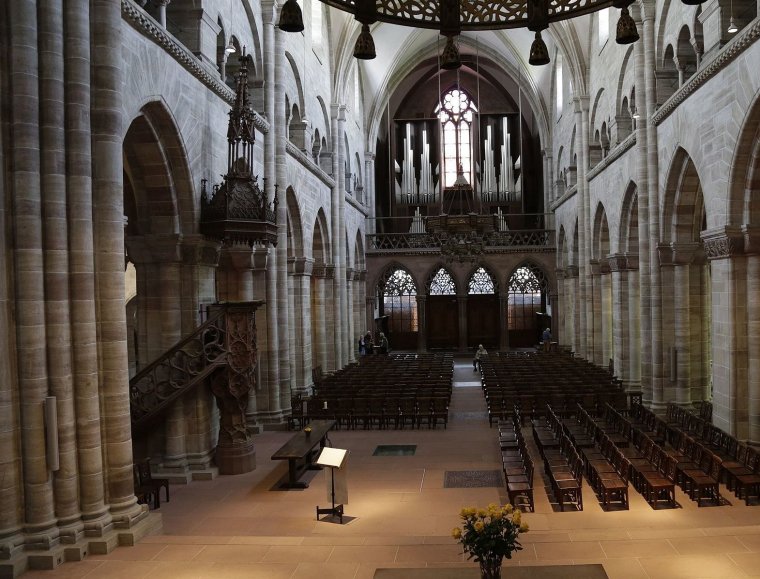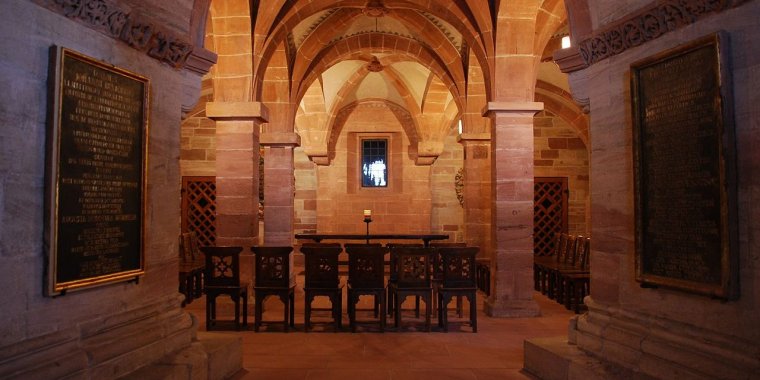| Travel / Tourist Attractions |
Basel Minster (Basler Münster, La cathédrale protestante Notre-Dame de Bâle), Basel, Switzerland
The Basel Minster is one of the main landmarks and tourist attractions of the Swiss city of Basel. It adds definition to the cityscape with its red sandstone architecture and coloured roof tiles, its two slim towers and the cross-shaped intersection of the main roof.
Originally a Catholic cathedral and today a Reformed Protestant church, it was built between 1019 and 1500 in Romanesque and Gothic styles. The late Romanesque building was destroyed by the 1356 Basel earthquake and rebuilt by Johannes Gmünd. This building was extended from 1421 by Ulrich von Ensingen, architect of the towers at the Ulm Minster and the Strasbourg Cathedral. The southern tower was completed in 1500 by Hans von Nußdorf.
The main front which points at the west is bestrided by two towers. The northern tower is called Georgsturm (64.2 m) and the southern tower is called Martinsturm (62.7 m). The towers are named after Georg and Martin, saints of the knights. Copies of both saints are portrayed by corresponding equestrian sculptures next to the main entrance upon high pilasters below the particular towers.
The statue of Holy Martin originated from the year 1340; today, the archetype can be found in the Klingentalmuseum. A mechanic clock and a sundial are located above the archetype. It is remarkable that the sundial of the Basler Münster shows the “wrong time” due to the Basler Zeit. Below the Georgsturm a monumental picture (1372) can be found which shows knight Georg fighting against a remarkably small dragon.
After a heavy earthquake in 1356 the Münster, which originally had five steeples, was reconstructed with only two steeples remaining. At the older Georgsturm, the lower brighter part that has remained untouched, can still be seen. In 1500 a gorgeous finial was put on top of the Martinsturm.
By using the steep spiral stairs in the southern steeple it is possible to see the old church clock from 1883. The belfry is situated in between the two steeples which are connected through a gallery. Georgturm and Martinsturm can both be accessed by 242 stairs. From there one can get an overwhelming view of the city of Basel and the foothills of the Black Forest and the Jura Mountains.
Both of the steeples consist of three lower, undivided storeys and several Freigeschosse. The two lower storeys are simple and block-like. The steeples’ upper storeys soar up the tracery gallery. As those were not constructed simultaneously, they differ slightly in their outer appearance.
In contrast to the southern steeple, the octagonally cross-sectioned steeple and the steeple topping attach only over a rectangle storey at the northern steeple. Comparable to the Freiburger Münster, lank Fialentürme project at the corners of the octagons.
An empty column, which originally carried a statue of the Virgin Mary, is situated between the doors of the main porch. As it is typical of many other Gothic church porches, the tympanum above is likely to have depicted the Last Judgement. Both were destroyed during the Reformation Era. In contrast, the curvatures depicting prophets and kings, roses, dancing angels and Abraham have been preserved.
The benefactors Henry II and his wife, Empress Kunigunde, are portrayed left of the main porch. In the portrait, the emperor, depicted as a surprisingly young and beardless man, is carrying a church model in his arms, which identifies him as the benefactor. Only after the renovation of the exterior (1880 – 1980), the empress was given a cross as another symbol of identification. Originally, she was carrying gloves.
On the right one can see the pictures of a seducer (“Prince of this World") and a misguided virgin.
While the virgin smiles and starts to undress, toads and snakes crawl in the back of the seducer. They should embody the evil. The image dates back to roughly 1280. The statues and brickwork of the cathedral consist of red sandstone which was found in Wiesental and Degerfelden.
The Galluspforte (Gallus portal) on the western façade is a magnificent sculptural work. Figures carved on the main (south) façade include St. George slaying the Dragon. Inside, there's a sandstone lectern, and a crypt with tombs of early bishops of Basel; also buried here is Jacob Bernoulli, who discovered the mathematical constant e.
Münsterplatz. Nov-Mar M-Sa 11:00-16:00, Su 11:30-16:00; Apr-Oct 10:00-17:00, Sa 10:00-16:00, Su 11:30-17:00. Free; Fr 5 to climb towers.
Sources
• www.wikivoyage.org
• www.wikipedia.org
YOU MAY ALSO LIKE
